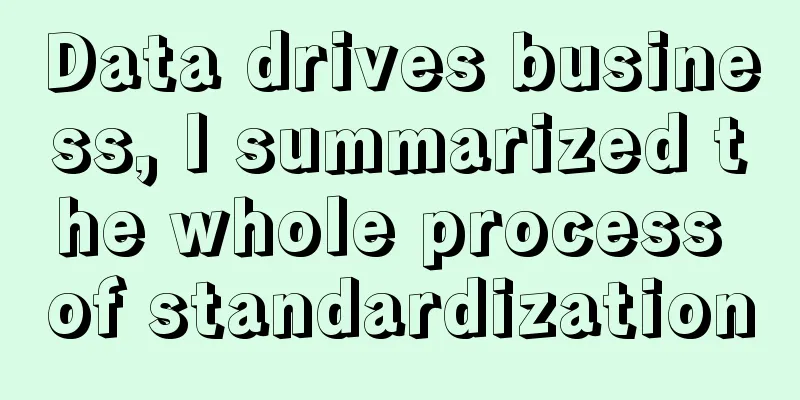Data drives business, I summarized the whole process of standardization

"Drive business" is the word that data people fear the most. Oh my god, drive business? I am lucky enough that I am not chased by the business department every day to count my achievements. How can I drive business? But leaders love to ask this kind of request. Today we will talk about it in detail. First of all, we need to distinguish who is asking this question. It is very important. Q: What is the difference between the following two situations? A. Business department leader asked: How does data analysis drive business development? B. The data department leader asked: How does data analysis drive business development? A: The leading authority is different. If the business department asks for suggestions, they can directly implement them. The data department is just an auxiliary. If what they say is not to the business's liking, it will always hang in the air. Just like driving a car, the person holding the steering wheel can change the route after listening to the suggestions, but the person sitting in the passenger seat makes too many noises and is easily disliked. Therefore, different people ask different questions, and the response ideas are different. Today we will first talk about business questions. 1. Wrong Ways to Drive BusinessWhen many students hear “data drives business”, their intuitive thoughts are:
If you do this, you will definitely be criticized by the business. Just a few questions: 1. Who will do it? 2. When will it be done? 3. How much did you get? 4. How much does it cost? 5. Can’t I do something else with this money? 6. Should I use a big turntable or water the flowers and trees? 7. When watering flowers and planting trees, will you give away real fruits or coupons? 8. Should I use coupons, points or gifts? 9. The coupons are worth 10, 20, 30, 40, 50... ? 10. Is it okay if it is successful but the conversion rate drops? I can't answer any of them. What's the mistake? The mistake is to oversimplify the business. Even if it seems simple, "the activity rate is low", if you really want to take action, you have to consider the many links listed above. And some of these links cannot be solved directly by data (such as the creative design of the sign-in activity, watering flowers, planting trees, raising golden pigs, making electrical appliances... these cannot be calculated by addition, subtraction, multiplication and division). Therefore, if you want to promote business, you must carefully classify business work and find the focus of data. 2. Entry points for promoting businessSolving business problems, from deciding to initiate a project to completing its execution, is divided into four major steps (as shown in the figure below): Throughout the process, data analysis cannot solve all problems. As a rational and quantitative tool, data analysis is more suitable for solving strategic and tactical decision-making work and for monitoring the battle situation. As for combat actions, data can only be used as a reference. An experienced planner is far more useful than addition, subtraction, multiplication and division. Therefore, only by arranging the output products reasonably can we better drive the business to take action, rather than letting the business suffer from data dependence: "Can you use artificial intelligence big data to analyze how red and green the colors of my painting should be?" - This is not how data is used. 3. The order of promoting businessOnce the output content is clear, the order of promotion can be planned. Many newcomers here make this mistake: they expect to achieve everything in one step, and they work hard to make a very detailed plan that is executable, and they consider it a success. This directly replaces the work of the business, and they are exhausted; secondly, the business will not appreciate it - "Who do you think you are? You make decisions for me??!!" Remember: No one can predict the future and plan everything clearly at the beginning. The process of promoting business is gradual, from unclear to clear, and gradually deepened on the basis of continuous consensus. Especially some key nodes: who is responsible, how much budget, what are the assessment indicators, how much assessment. These need to be confirmed by consulting department leaders, or even by consensus between departments and the boss. So you have to be patient and take it step by step (as shown in the figure below). 4. Pitfalls in promoting businessThis discussion is based on "business department leaders asking questions and personally participating in the discussion", so if you want to promote data, you have strong support from the upper level. However, even if you have the imperial sword, you may not dare to pull it out and kill people at will. In the specific promotion process, there are some common pitfalls for newcomers, which must be paid attention to: 1. Directly trust the judgment of the businessNote that business judgments may not always be based on data, or even facts. Very common, such as:
Yes, all kinds of emotions, positions, and single events can interfere with people's judgment. So when the business tells you: our activity rate is not good; our conversion rate needs to be improved; our user experience is not good, we must trace the source of the problem, implement it to a number or an event, and discuss specifically what the problem is. 2. No relevant indicator analysisMany non-profit and cost indicators are prone to vanity effects: 1. Easy to be inflated: once the big turntable is shaken, the activity rate is very high! 2. No actual output: So what if the activity is high? He won’t buy. 3. No long-term effect: What happens after the short-term stimulus? If there is no activity, the market will fall again. Therefore, when the business focuses on these indicators, it is necessary to do relevant indicator analysis, especially to link them to an indicator with ultimate assessment significance, such as profit, cost, etc. At least it is necessary to ensure that these main indicators are linked. It is allowed to have some vanity elements, but they cannot be all water. 3. Not defining goals upfrontThis is also what business often does: 1. I want to increase my activity rate from a certain level to a certain level? I don’t know! 2. I want to increase my consumption - from how much to how much? I don't know! 3. I want to boost sales - from what level to what level? I don't know! 4. I want to activate the user - what is dormant? How to activate? I don't know! Yes, many business departments work completely based on experience, feeling, and habit. They have never thought about what indicators to evaluate and how much to do. When asked, they don’t know, or they just say: "Compare it with the natural state?" The problem is that many businesses are constantly promoting and holding activities, so how can they be in a natural state? So if you want to do data-driven, you must look at the data carefully and set goals, and you can’t be vague. 4. Past strategies are not collectedI didn’t collect all the strategic goals, playing methods, and effects I had used in the past. As a result, I didn’t know what to look at when I needed data support, and I had to make decisions based on experience in the end (as shown in the figure below). 5. Innovation has no labelsSimilarly, if you want to test innovative solutions, you need specific labels to facilitate comparative analysis later. Otherwise, you will only see a rough response result, which still cannot guide the detailed design work. 6. Not looking at the overall picture of the test planThis is another extreme of the previous problem. When testing, too much attention is paid to details, such as the color of the page, the left and right sides of the button, and too much entanglement with coupons of 20 or 30. As a result, the details are seen but the overall picture is ignored. When it comes to users, they think: What a crappy activity, I don’t want to participate. 7. No monitoring during executionIn a hurry to launch, the requirements were changed repeatedly, and finally the embedding points were not done well, and the data was not connected. The result was, naturally... In short, data drives business, just like driving a car with navigation. Everyone thinks navigation is easy to use, but in the end, the navigation function requires complex systems such as GPS positioning, road maps, real-time data feedback, route planning algorithms, etc. It is easy to say in theory, but in practice, we can only see the difference and cherish it. Moreover, this is still under the promotion of the business department. If the data department wants to promote it, it will have to put in more effort. Data-driven business is difficult, but anyone who does data analysis cannot escape this hurdle. How can one become a professional data analyst and drive business development through data? Author: Down-to-earth Teacher Chen Source: WeChat public account "Down-to-earth Teacher Chen (ID: gh_abf29df6ada8)" |
<<: Carrot Run "Information Explosion"
>>: Story economics, let your marketing touch people's hearts
Recommend
Before joining Haidilao, did you know that it does not make money from products and services?
Haidilao has always been famous for its service at...
How can brands break through in 2023?
In the new world order, the world is facing a majo...
Has the “Hope of the Audience” video account realized Tencent’s short video dream?
On December 15, at an online internal employee con...
What is the Lazada transaction fee? How does Lazada charge commission?
If you want to open a store on Lazada, merchants m...
From Southeast Asia to Japan and South Korea, Mixue Ice City's overseas expansion
Recently, many netizens posted photos of the grand...
Is Shopee's base currency set in RMB or USD? What are Shopee's fees?
Friends who do cross-border e-commerce should all ...
Thinking health products are targeting parents again
Since the popularization of anti-fraud knowledge, ...
8 favorite sentences in January
Unconsciously, we have passed the first month of 2...
What is the meaning and function of Amazon advertising portfolio?
Everyone will place Amazon ads. When placing ads, ...
Three pictures to explain content marketing in the World Cup
This article analyzes the specific content marketi...
What documents are needed for a company to settle foreign exchange? How long does it take for a company to settle foreign exchange?
Foreign exchange settlement by enterprises refers ...
What are the management advantages of a cross-border e-commerce manager? How to do it well?
With the rapid development of globalization and th...
How does Amazon deliver goods by itself? How does it work?
Amazon has three delivery methods: overseas wareho...
These 27 types of content on Video Account will be restricted, so don’t post them anymore!
Understanding what content will trigger these rest...
How is the cross-border e-commerce flower stand business? How to choose the category?
The cross-border e-commerce flower stand business ...









